As an Amazon Associate I earn from qualifying purchases.
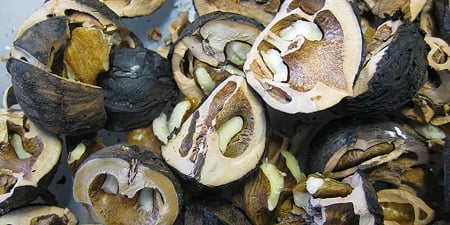
You’d think that if anything would bring out the Greed of Man in me, it would be truffles, a sexy, intoxicating food that can fetch $300 a pound or more. Yet I’ve given plenty of them away to my friends without a second thought.
No, what really makes me feel like Gollum from Lord of the Rings, the wild food I hold most precious, is my store of shelled black walnuts. Don’t even ask. You can’t have any. They are mine I tell you, all mine!
For those of you who don’t know what a black walnut is, it is a generic term for the wild walnuts native to North America. There is one main species east of the Rockies, two in California, and a couple of others in Arizona and Texas. Black walnuts are, more or less, related to hickory nuts and butternuts.
What’s the difference between black walnuts and the kind you get in the store? The vast majority of walnuts you buy in stores are English (also called Persian) walnuts, which are larger and easier to shell than black walnuts. In some places you can buy them in stores, and you can buy black walnuts online.
Size is not the main difference between black walnuts and domesticated ones. Flavor is. Black walnuts taste far stronger than regular ones: More concentrated, walnut-y, and even a touch more bitter.
To me they are the difference between cream and skim milk, grouse and chicken, a wild strawberry and one of those gigantic ones grown on the coast of California. I will take black walnuts over regular ones any time, and for any price.
Luckily that price is free: Black walnut trees grow all around us here in Northern California. My friend Josh tipped me off to a great spot, too, which has so many old trees it took my just 10 minutes to fill two 5-gallon buckets.
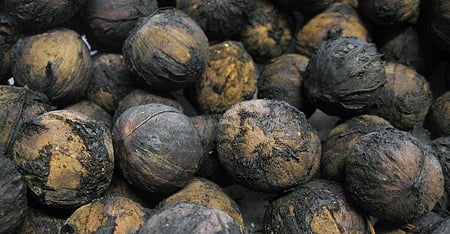
OK, maybe I lied. Black walnuts are not free — if you take time into consideration. Nothing I have ever done, not winemaking, gardening, big-game hunting, processing acorns or curing olives is as labor-intensive as harvesting, hulling and shelling black walnuts. As my fellow forager Connie Green says, “black walnuts are a fortress.” Here’s the method I figured out to storm the gates.
First you need to harvest the walnuts at the correct stage of ripeness.
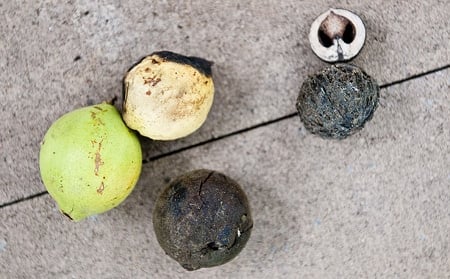
For starters, walnuts will probably not be ripe where you live until October, so wait until then to begin. November should be fine, too, and you can pick up fallen nuts from the ground around the trees into December, but by then our Little Gray Friends the squirrels will have had at them.
So you’re standing at a tree. You see all these forms of walnuts in front of you. Which to pick?
Green ones will most likely still be on the trees. Yes, you can collect them, but they have a surprise in store for you. The beige ones are rotting green ones — they are the hardest to work with, but the nut inside will still be fine. The black one at the bottom is how you will find most of your walnuts: It has its hull rotted and is pretty dry. Finally, if you’ve had lots of rain, you will find some nuts that will be pre-hulled, like the one under the half-shell.
Pick only pre-hulled walnuts that feel heavy for their size, as they will dry out in the shell once hulled.
For the most part, you will need to hull your walnuts. Lots of people say you should just drive over them with a car, but this stains your driveway. Stain? Why yes. Black walnut juice stains like nothing else. And it will not come off with any amount of scrubbing. If you fail to wear gloves when you hull black walnuts, you will have the Black Hand of Death for several days.
Sam Thayer, in his book Nature’s Garden, suggests stomping on the hulls in the field to get them off. This works, but incompletely in my experience with Northern California walnuts, Juglans hindsii. So I sit outside on my porch with three buckets — one with walnuts in it, one for the soon-to-be-hulled walnuts, and one for the hulls. I then don gloves and use a pocketknife to hull the nuts by hand.
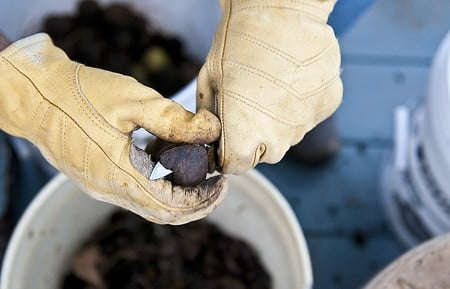
You want a relatively dull knife that you can slice with and not be in danger of it piercing your work gloves. The work can get a little slippery, especially with the green walnuts — remember the surprise? That’s it. A half-hulled green walnut is slipperier than goose shit on a doorknob. This is why I prefer the walnuts with the fully rotted black hulls.

Beware when you are hulling walnuts outdoors. Our Little Gray Friends could be lurking anywhere, just waiting to steal your walnuts for themselves. I use a biological countermeasure to keep the squirrels away:

Once hulled, your work has just begun. Now you must shell your walnuts.
This is the point at which you can kick back a bit. Hulled walnuts store well in the shell, and in fact crack better once they’ve dried for a few weeks.
Once you start shelling, however, you need to banish from your head all notions that you will be able to crack black walnuts and get those pretty perfect halves you can get with regular walnuts. Won’t happen. Bits and pieces are the price of precious black walnut meats.
I crack mine with a hammer, on the concrete floor of my garage. Such force is necessary. I’ve never heard of a regular nutcracker fierce enough to break a black walnut, although some people in the Midwest, where the Eastern species lives, have created special black walnut shellers. Anyone ever use one? I’ll buy one if they work well…
The key to the hammer technique is to use a terrycloth towel to cover the nuts, so the pieces don’t fly all over the room. Use a towel you don’t care about, as it will get holes. Smack the nut with enough force to break it, but not enough to pulverize the nut; after a few, you’ll get the hang of it.
So now you have a bucket of cracked nuts. You’re still not done! Now you need to gently remove the meats from the impossibly complex interior of the walnut. I find the best piece of equipment to do this is a stout pair of wire cutters and a nutpick. I use the wire cutters to clip the shells in key spots so larger pieces of walnut fall out. Again, after a few dozen nuts you’ll begin to know where to clip. The nutpick’s use is obvious. This is tedious work, people. I do it while watching football.
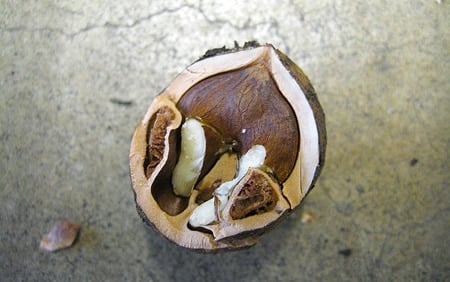
Let me tell you before you begin a black walnut adventure that you need to be patient. It took me probably six hours of work to get 15 ounces of nutmeats — although that includes hulling all of my nuts, not just the portion I cracked and picked. But all this work is worth it.
Just the aroma of black walnuts is payment for the effort: They smell toasted without actually being so. And I’ve already mentioned the flavor, which is so strong many recipes say just half the amount of black walnuts will fully replace the flavor of regular ones. I’m not so sure about that, but you can use a bit less. If you want.
Which brings me, finally, to what I do with my black walnuts. In holiday season, I make a Christmas cookie from my childhood:
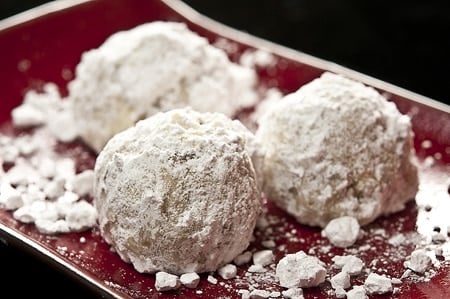
It is my version of a traditional walnut snowball cookie, also known as a Russian teacake or a Mexican wedding cake. My version has black walnuts, of course, but also orange flower water and a little orange liqueur. It’s an awesome cookie, a riff off one my mum has made for decades.
These cookies are stupid easy to make — no mixer necessary, just clean hands — and are so good you really need to make a double batch, because you will eat half of them before your friends or family come home. Trust me on this one.





My grandma trained me well in early childhood. I cracked black walnuts, hickory nuts, and butternuts with the hammer-and-stone method for the promise of nut filled cakes and cookies. Finally in my old age I have found your actual yes-it-really-works purpose-built black walnut cracker. It ain’t cheap, but since I am as greedy about black walnuts as a hobbit about mushrooms, it was worth the price. Cuts my cracking time by 3/4s and gets me much bigger pieces; often I even get complete half walnuts. Yes they are available online, and No I have no affiliation with the maker. Check out Grandpa’s Goody Getter from one Mr. Bacon in Missouri. Enjoy!
We tumble the whole nut in a cement mixer with some water and gravel. This removes the outer hull. Then we separate the nuts from the water/gravel mixture, let them dry, and crack them open with a vise. A small pointed knife helps pry the nut pieces away from the shell. Beware – shell pieces look like nut pieces until the shell dries and is darker/redder than the nuts. We have used the walnut stain on wood and cloth, as a preservative, and to discourage weeds.
I have a tree in my yard and have begun the harvest. Standing next to my Black Walnut is a Chinese Chestnut. Both trees are 50 or more years old.
Happy Harvesting.
c
I have harvested green walnuts, just bang them with a hammer and then let the nuts dry out (I have had a problem with mold and so have to be careful about that). Hickory nuts are much worse to shell but also very good.
I have one of those black walnut shellers that you mentioned in this article; yes, it works and easy to use. Mine is likely an antique, so I don’t know if they’re still made. Shoot me an email if you want a picture.
Awesome article and comments. I used to have a source for these wonderful delicacies. It was very entertaining to endure the harassment form squirrels who challenged my right to their bounty!!!
Thank you for the recipe I am about to try. (I loved the “biological” squirrel deterant.)
I am the grandma in this family. A friend gave me some of her black walnuts after a rain on Wednesday. We donned gloves and hulled them right there in her yard. Those wet husks slipped off fairly easily. I filled two cake pans, then put them in the oven at 170 degrees for a few hours. Next I transported them to my daughter’s house , unsuccessfully employing the boys to help me hull them. Well, they were successful in making a fine mess. After the children were in bed I noticed I was sweating over the vice, laboriously cracking them three at a time. I carefully cleaned the area, (trying to be the GOOD mother in law…) In the kitchen I began picking through the “concrete” hulls for the soft meats, and after quite a few tunneling tries, began laughing at my only companion, (my invisible friend Jesus) because He had created such uncanny channels and curves in that cement hull that defied my reason. I couldn’t think of any logic for those strange twists and turns, and I was pretty sure there was no money in assigning it to a university biology student to figure out, so it will remain a mystery. Jesus was laughing too. I will do this again, as He makes good company, and it appears this is the only way to satisfy my taste for the black walnuts!
I am a novice, but possible tips are:
1. Hull black walnutsafter a rain
2. Use the vice after the kids are in bed
3. Invite some good company to do it with!
How clean must you get the nut after taking off the hull?
Kimbereley: Not very.
My grandmother from LA . . . no not the one in California . . . but lower Alabama used the ink from the hulls to cure a plethora of fungal things like ringworm, athlete’s foot, etc
This is awesome! Our Black Walnut tree is full this year & I will try to hull with the car ride over method! How do squirrels hull so many nuts? Even our tiny red squirrels! Has anyone figured out how to train squirrels to hull nuts & leave rest for me?!??
I’ve lived in the same house for 37 years and for 37 years I’ve gotten the biggest kick out of bowling these nuts down the street. Yes, I knew all about the benefits of cooking with black walnuts yet couldn’t bring myself to the ugly task of hulling them. It’s late September, 2017 and I think I’m gonna do it. Yup, I’m gonna use those nuts for your Christmas Cookie recipe. I too remember my Mother and Grandmother making those same cookies. So now to hull them. I’m going to place them in the street and each time a car runs over them I’m going to take that nut back to the house and wait for the rest to dry up so I can use by December. Thank you.
We have cracked several black walnuts and the nut meats are rubbery. Does that mean they are not ripe yet?
When I remove the hull from the walnut I often find lots of small white worms. what causes them and are the walnuts still good?
Sue: Yes, the walnuts are still good. The worms eat the hull.
black Walnuts make a fine liqueur find recopies online
Hi Hank – I’m writing from North Yorkshire UK. I’m a forager, planter, maker cook and we are having a bumper harvest here in UK this year. I have walnuts raining down they are green (not black) any hints on shelling from husk? Do I need to do as soon as harvested or can I leave in their green husk (till I get back from holiday in a week).
Claire: you should be fine for when you return.
I live in Minnesota and have a Black Walnut tree in my yard. This is year it is heavy with walnuts. I want to beat out the squirrels and harvest the nuts before them. You said they can be harvest in October and November but that might be late here in MN. What do you think? This is the first year that we have had this many on our tree. It’s still a young tree.
Thanks
Colleen: I’d wait until the squirrels start eating them, then start picking. Maybe September?
the best way I have found to crack out black walnuts is in a large vise. place in vise with ends on vise faces. tighten to crack them in half or if lucky quarters. repeat with halves to make quarters. then take quarters and nip half way down side with side cutters to split quarters. I get about 75% in halves and quarters. never bother with a nut pick any more. usually about an 8 ft pickup bed full most years
I have a tree in my backyard and am wondering all about this process. I know that this treee is at least 40 years old. Is it a keeper?
Judi: Only one way to find out. Start harvesting the nuts!
My grandfather invented a huller that people from around Chesterfield county came to use.The Tinsley Griggs huller is clean metal barrel that has punctures all over it. These makes sharp edges on the inside of the barrel. The barrel has a spindle going through it long ways and that’s attached to a small motor. His was a knife / tool sharpener or grinder. There was a trapdoor on the other side the lead that held together with a simple bit of wire. After Rolling In the barrel for a while the nuts came out clean.
Dang, Hank, I just moved and have several Eastern Black Walnut trees on the property, including one that towers at least 60 feet. Harvesting and using is gonna take some effort it seems. Thanks for all the info.